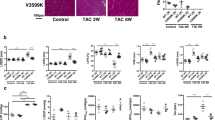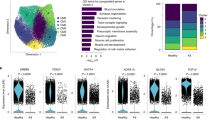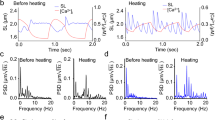Abstract
Previously, we demonstrated in vivo that the nature of the alterations in sarcoplasmic reticulum (SR) function and SR Ca2+ regulatory proteins depends both on the type of mechanical overload imposed and on the duration of the heart disorder. The purpose of the present study was to determine in vitro whether an extrinsic mechanical overload (in the form of high ambient pressure) would cause an up-regulation of ryanodine receptor (RyR) and Ca2+-ATPase, as we previously reported mildly pressure-overloaded, hypertrophied rat hearts. Primary cultures of neonatal rat cardiomyocytes were prepared and high ambient pressure was produced using an incubator and pressure-overloading apparatus. Cells were exposed to one of two conditions for 72 h: atmospheric pressure conditions (APC) or high pressure conditions (HPC; HPC=APC+200 mmHg). The expression levels of RyR and Ca2+-ATPase were quantified and functional characteristics were monitored. The cell area was significantly greater under HPC. After 6 h exposure, the physiological properties of cardiomyocytes were impaired, but they returned to the baseline level within 24 h. After 24 h exposure, the expression level of RyR was significantly higher under HPC, and for Ca2+-ATPase, the expression level was significantly higher under HPC after 6 h exposure. HPC caused hypertrophy and up-regulated the expression of Ca2+ regulatory proteins and their genes. We suggest that this in vitro pressure-overloading model may prove useful, as is a stretch-overloading model, for investigation of the intracellular Ca2+ regulatory pathways responsible for the development of cardiac hypertrophy.
Similar content being viewed by others
Article PDF
References
Arai M, Matsui H, Periasamy M : Sarcoplasmic reticulum gene expression in cardiac hypertrophy and heart failure. Circ Res 1994; 74: 555–564.
Diamond JA, Phillips RA : Hypertensive heart disease. Hypertens Res 2005; 28: 191–200.
Hisamatsu Y, Ohkusa T, Kihara Y, et al: Early changes in the functions of cardiac sarcoplasmic reticulum in volume-overloaded cardiac hypertrophy in rats. J Mol Cell Cardiol 1997; 29: 1097–1109.
Ohkusa T, Hisamatsu Y, Yano M, et al: Altered cardiac mechanism and sarcoplasmic reticulum function in pressure overload–induced cardiac hypertrophy in rats. J Mol Cell Cardiol 1997; 29: 45–54.
Ueyama T, Ohkusa T, Hisamatsu Y, et al: Alteration in cardiac SR Ca2+-release channels during development of heart failure in cardiomyopathic hamsters. Am J Physiol 1998; 274: H1–H7.
Ueyama T, Ohkusa T, Yano M, Matsuzaki M : Growth hormone preserves cardiac sarcoplasmic reticulum Ca2+ release channels (ryanodine receptors) and enhances cardiac function in cardiomyopathic hamsters. Cardiovasc Res 1998; 40: 64–73.
Cadre BM, Qi M, Eble DM, et al: Cyclic stretch down-regulates calcium transport gene expression in neonatal rat ventricular myocytes. J Moll Cell Cardiol 1998; 30: 2247–2259.
Simpson P, McGrath A, Savon S : Myocyte hypertrophy in neonatal rat heart cultures and its regulation by serum and by catecholamines. Circ Res 1982; 51: 787–810.
Ing DJ, Zang J, Dzau V : Modulation of cytokine-induced cardiac myocyte apoptosis by nitric oxide, Bak, and Bcl-x. Circ Res 1999; 84: 21–33.
Kawata Y, Fujii Z, Sakumura T, et al: High pressure conditions promote the proliferation of rat cultured mesangial cells in vitro. Biochim Biophys Acta 1998; 1401: 195–202.
Mizukami Y, Iwamatsu A, Kimura M, et al: ERK1/2 regulates intracellular ATP levels through alpha-enolase expression in cardiomyocytes exposed to ischemic hypoxia and reoxygenation. J Biol Chem 2004; 279: 50120–50131.
Mullis K, Faloona F, Scharf S, et al: Specific enzymatic purification of DNA in vitro; the polymerase chain reaction. Cold Spring Harb Symp Quant Biol 1986; 51: 263–273.
Ohkusa T, Ueyama T, Yamada J, et al: Alterations in cardiac sarcoplasmic reticulum Ca2+ regulatory proteins in the atrial tissue of patients with chronic atrial fibrillation. J Am Coll Cardiol 1999; 34: 255–263.
Lompre AM, de la Bastie D, Boheler KR, Schwartz K : Characterization and expression of the rat heart sarcoplasmic reticulum Ca2+-ATPase mRNA. FEBS Lett 1989; 249: 35–41.
Maki M, Takayanagi R, Misono KS, Pandy KN, Tibbetts C, Inagami T : Structure of rat atrial natriuretic factor precursor deduced from cDNA sequence. Nature 1984; 309: 722–724, 1984.
Tso JY, Sun X-H, Kao T, Reece KS, Wu R : Isolation and characterization of rat and human glyceraldehyde-3-phosphate dehydrogenase cDNAs: genomic complexity and molecular evolution of the gene. Nucleic Acids Res 1985; 13: 2485–2502.
Takahashi T, Allen PD, Izumo S : Expression of A-, B-, and C-type natriuretic peptide gene in failing and developing human ventricles: correlation with expression of the Ca2+-ATPase gene. Circ Res 1992; 71: 9–17.
Komuro I, Kaida T, Shibazaki Y, et al: Stretching cardiac myocytes stimulates protooncogene expression. J Biol Chem 1990; 265: 3595–3598.
Komuro I, Katoh Y, Kaida T, et al: Mechanical loading stimulates cell hypertrophy and specific gene expression in cultured rat cardiac myocytes. J Biol Chem 1991; 266: 1265–1268.
Arai M, Suzuki T, Nagai R : Sarcoplasmic reticulum genes are upregulated in mild cardiac hypertrophy but downregulated in severe cardiac hypertrophy induced by pressure overload. J Moll Cell Cardiol 1996; 28: 1583–1590.
Yamazaki T, Komuro I, Kudoh S, et al: Role of ion channels and exchangers in mechanical stretch–induced cardiomyocyte hypertrophy. Circ Res 1998; 82: 430–437.
Sadoshima J, Jahn L, Takahashi T, Kulik TJ, Izumo S : Molecular characterization of the stretch-induced adaptation of cultured cardiac cells: an in vitro model of load-induced cardiac hypertrophy. J Biol Chem 1992; 267: 10551–10560.
Fisher SA, Buttrick PM, Sukovich D, Periasamy M : Characterization of promoter elements of the rabbit cardiac sarcoplasmic reticulum Ca2+-ATPase gene required for expression in cardiac muscle cells. Circ Res 1993; 73: 622–628.
Shiojima I, Komuro I, Yamazaki T, Nagai R, Yazaki Y : Molecular aspects of the control of myocardial relaxation, in Lorell BH & Grossman W ( eds): Diastolic Relaxation of the Heart. Norwell, Kluwer Academic Publishers, 1994, pp 25–32.
Author information
Authors and Affiliations
Corresponding author
Rights and permissions
About this article
Cite this article
Sato, T., Ohkusa, T., Suzuki, S. et al. High Ambient Pressure Produces Hypertrophy and Up-Regulates Cardiac Sarcoplasmic Reticulum Ca2+ Regulatory Proteins in Cultured Rat Cardiomyocytes. Hypertens Res 29, 1013–1020 (2006). https://doi.org/10.1291/hypres.29.1013
Received:
Accepted:
Issue date:
DOI: https://doi.org/10.1291/hypres.29.1013
Keywords
This article is cited by
-
Manifestations of gene expression profiles in human right atrial myocardium caused by mechanical stretch
Heart and Vessels (2021)
-
Cardiomyocyte stretching for regenerative medicine and hypertrophy study
Tissue Engineering and Regenerative Medicine (2015)



